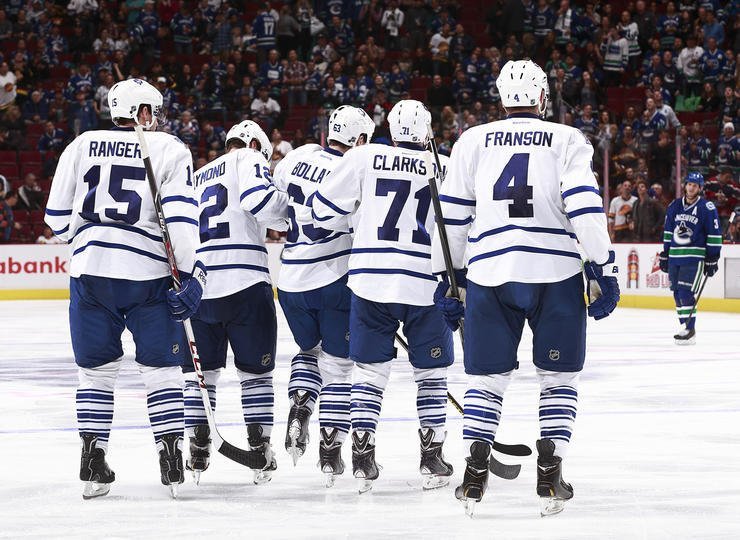We looked at options with the Maple Leafs under contract last week. Today, let’s take a look at the UFAs and RFAs.
UFAs
Dave Bolland
Quick Thoughts:
Had a hot start with the Leafs before getting hurt and coming back playing on what looked to be one and a half legs. Really tough to get a read on him based on what he did in Toronto because he simply didn’t play long enough in good health to do so. Based on his past history, he’s a solid 3C and probably the Leafs best defensive center considering what else they have (Bozak, Kadri, McClement…). He’s only turning 28 this year, so he should have a lot of mileage left, but he can’t seem to stay healthy.
Selling low or high?
Well, that depends who you’re talking to. To some, he is a two-time champion who was very good to start the year, which is what you can expect from him over a full season when healthy. To others, he is an injury prone cast off of the Cup champs with more reputation than substance. NHL GMs should take his injury history seriously and be concerned about it, and that should push his market value down… But free agency rarely works that way. They’d most likely be overspending to retain Bolland, but it’s really tough to get a true read here. It only takes one team to drive up his price.
Verdict:
If Bolland can be brought back on a show-me/prove it deal, it’s worth exploring, but it should be a no brainer if he really wants the rumoured $5M on a long-term deal. Even if they do bring him back on a short term deal, it only makes sense to do so if they move Bozak. They can’t just bring back the gang at center (Bozak-Kadri-Bolland) and expect to improve next season. One thing working in Bolland’s favour is that he’s one of the youngest centers available in free agency and has a track record in the league while only turning only 28 this year. That is a small consideration. To sum up: Short term for okay money is fine (pending another move at C), long-term is bad.
Nik Kulemin
Quick Thoughts:
Was in a checking role playing with an offensive anchor in McClement for quite a bit this past season, but 20 points in 70 games is still extremely low. Did put together some points playing with Lupul and Kadri, and when he played with them he actually made them better by assuming defensive center responsibilities for Kadri and getting in first on the forecheck to turn pucks over. He’s listed at 6’2, 225, but the Leafs have made note of him being over 240 pounds a few times so he’s probably bigger than the original listing. Overall, he’s just a really big body for the Leafs who impressed at center and has proven he can play any forward position.
Selling low or high?
In the three seasons since his 30 goal year, Kulemin has 71 points in 188 games (.38PPG). Yeah, he hasn’t had much power play time and he’s been relegated to a checker, but those numbers shouldn’t get him the raise he probably wants on the $2.8M he’s been making. If anything, due to that, his value might come at a discount and they could be buying low here. One looming question in the background is whether they’d be bidding against the KHL.
Verdict:
Last season, I was ready to trade MacArthur before Lupul got hurt and MacArthur stepped up alongside Kadri to provide good secondary scoring, helping the Leafs survive the Lupul injury and get into the playoffs. My mind changed on him at that point because I liked the versatility of his ability to add scoring up and down the Leafs line-up. Kulemin was going down the path of “career grinder that they can find anywhere,” but two things happened to change my mind: 1) He can suddenly play center; 2) Unlike Clarkson, he could actually play with Kadri and Lupul and actually make them better. For a team that has five forwards signed next season, adding a guy who can play any forward position makes it a lot easier to build the line-up and fill holes. It is worth it if they can get him around the $3M range. If he wants $4M+, he simply isn’t worth that considering his play the last few years.
Jay McClement
Quick Thoughts:
Became a target of criticism even though it wasn’t his fault Carlyle was playing him 18+ minutes for what seemed on the regular. Was given match-ups that he couldn’t handle while the PK also suffered this season. He’s a fourth line center who was playing way over his head this season. He also put up a career-worst 10 points despite playing almost 15 minutes a night over 81 games. In the lockout shortened year, he had 17 points.
Selling low or high?
Well, he had a career worst season points wise and the PK, which he is a staple of, was third worst in the league. After the lockout season he might have been able to command some money, but not this summer.
Verdict:
McClement turned 31 this year so he isn’t that old, but it looks like it is time to move on with Holland needing to play full-time next year and the PK being so bad with him. McClement is a nice veteran and a “check into the office and go to work” type guy, but he doesn’t bring them anything unique nor does he help them much 5v5. He was part of the Leafs lack of depth scoring (Clarkson, enforcers, kids playing 2 minutes and not scoring) that hurt the team and made the staff feel like they had only two lines to play at times throughout the season. With so many Marlies looking ready, it’s time to move on here.
Mason Raymond
Quick Thoughts:
Extremely fast and skilled with the puck, Raymond was able to open up space for his teammates and gain the zone with ease. Was a regular on the penalty kill, but wasn’t able to use his speed to his advantage as he often chased the puck and didn’t close out lanes. Also didn’t use his speed to get in on the forecheck or create turnovers. To a degree, he embodied the Leafs this year: Great in open ice but couldn’t deliver in the tough areas.
Selling low or high?
Raymond put up the second highest point and goal totals of his career this season as a Leaf. He’s turning 29 this summer and is in line for a nice pay raise. Last summer, he couldn’t get a respectable offer and came to training camp without a contract, so this summer he should be looking to cash in on a big year. This is buying high, for sure.
Verdict:
At 29, looking to cash in on a big year, it wouldn’t make much sense to bring him back for the money I’m assuming he wants, especially when you consider all the kids on the Marlies that look ready to challenge for a spot.
Troy Bodie
Quick Thoughts:
Nobody will call Bodie a good skater, but he surprisingly got around the ice quite well for a 6’5 grinder. He has 21 career NHL points and 10 of those came this season (in 47 games). Showed that he can cycle down low, get involved physically, and can actually play both wings, which is a nice perk to being a fourth liner. One of the few Leafs capable of forechecking.
Selling low or high?
Bodie earned a spot on the Leafs this season and put up his best NHL contribution to date, but he’s in no position to play hardball with anybody at 29 with 154 NHL games to his name. He might be a bit of a “buy high” by definition, but in the bigger picture what is that price? A $100-200K raise over the $600K he made last season?
Verdict:
If Bodie can be brought back for the aforementioned 700K or so, he’d be a nice player to bring back and play on the fourth line or serve as the 13th forward. He can play a regular shift, brings some size and can cycle and contribute. As long as he makes under $925K, they could waive him without cap penalty.
Paul Ranger
Quick Thoughts:
Made glaring errors to start the season, but he really settled in during the second half and played some solid hockey. At 6’3 and well over 200 pounds, he is strong as an ox with a bomb of a shot and he was third on the Leafs defense in goals this year. Ranger had 13 even strength points in 53 games along with one shorthanded goal, which prorates to 22 points over an 82 game year. Looking at the rest of the Leafs D, the breakdown of their even strength points this year went Phaneuf and Gardiner with 20 each, Gunnarsson with 16, and Rielly and Franson with 15 each. Ranger was also surprisingly very effective on the penalty kill and arguably their best penalty killing defenseman. Wasn’t a fan of Ranger on the right side, which is a little unfortunate.
Selling low or high?
Turning 30 this year, Ranger had an up and down season, sustained a serious injury, and played under 18 minutes a night. He showed some great flashes, but hardly enough to command big or even reasonable money in the market. Considering that was his first NHL season in years, there’s a good gamble to make that he’ll be much better next year should he want to continue playing in the NHL. By that token, they could be buying low on a guy who has a lot more to give but has shown he’s at least a solid third pairing defenseman.
Verdict:
If the Leafs can bring back Ranger on another deal, he’d be a nice player to retain as a third pairing guy at worst; worst case scenario is he’s on a cheap deal and gets passed by a kid next season. Best case is he takes a step forward after getting his feet wet for a year and becomes a second-pairing guy. It’s a good gamble if his price tag is cheap again.
Leo Komarov
Quick Thoughts:
Fan favourite type with a pretty big following for a guy who put up 9 points in 42 games. Is good on the PK and leaves a mark on most games he plays in. Like Kulemin, he also has the impressive ability to play every forward position, including center, which makes him a valuable add to any bottom six. Also like Kulemin, but not to the same degree, he can play up and down the line-up, which would have been nice to have this year for the Leafs when all the injuries hit.
Selling low or high?
He probably won’t come as cheap as he should based on his body of work, but in the big picture he wont cost a lot either. Can’t imagine a bidding war taking place on Komarov this summer considering he’s only played 42 NHL games and is 27, but could see a few teams being interested. That said, Komarov appears to love the Leafs and as long as a fair deal is offered he seems a safe bet to want to play in Toronto.
Verdict:
The nice thing about Komarov is that he’s more of a 9th or 10th forward on your depth chart versus a 11th-12th, and he can play PK or against top lines on occasion and not completely get run over. Point is, he’s more of a Bruins type fourth liner (Paille, Campbell), then a regular fourth liner (Adam Hall, Joe Vitale, etc.). For a team that should be integrating a few Marlies onto the roster next year, he’s a nice veteran with some game for them to play with on a third or fourth line so long as the money doesn’t get high and they can sign him for a reasonable number, he’s worth bringing back.
RFAs
Cody Franson
Quick Thoughts:
Played over 20 minutes a night for the first time in his career and really struggled. Was apparently hampered by a hip injury all year and it showed as he had trouble handling top six forwards consistently off the rush and retrieving pucks in the corner. Finished the season with an ugly stretch of 6 points in 24 games as the power play went ice cold. Was awful alongside Rielly and wasn’t as great playing with Gardiner as we hoped. His lack of mobility really stood out on this Leafs team because of how wide open they played.
Selling low or high?
His 33 points were a career high and he was one of the better power play producers in the league on the point, so the Leafs have a few things they can point to if looking to trade high on Franson. That said, he has yet to prove he can play well in an NHL top 4 and he’s turning 27 this year. How much are teams really going to give up for a 27 year old PP specialist?
Verdict:
The question with Franson is whether or not he can be a top 4. If he can’t, the Leafs can find cheaper alternatives (and his offense can easily be replaced in house between Rielly and Gardiner). If they think he still has room to grow as a top 4, then maybe there is a conversation to be had. Really, though, the bottom line is they can’t just give him away for nothing. Franson will put up points and can QB a power play; he moves the puck well and has some size. His game isn’t completely bereft of positives. When teams struggle, fans want to give everyone that was underperforming away for nothing and blow it all up. If the Leafs can get value back in a trade for Franson (a forward or high pick), it isn’t worth it to just get rid of him. If the market is dry, they could do worse than bringing him back on the cheap for a year and seeing if his game turns around.
Jake Gardiner
Quick Thoughts:
Had an up and down first half of the year, but looked to establish himself as a near untouchable down the stretch with electric play. Can be a one-man breakout and didn’t have the dependable type of partner he’d play best with; instead, he had to deal with a struggling Franson. Breaks neutral zone traps single handily and gains the offensive zone with ease. Is an effective rover that generates offense out of nothing; plays the more “modern” style of defense, which is what Chicago does with their D. Often looked up, saw his wingers were nowhere to be found, and had to do it himself. Is prone to lapses that either drive you crazy or make you scratch your head at times, though.
Selling low or high?
Turning 24 this year, Gardiner put up a career-high 10 goals and 31 points getting primarily secondary power play time. He also averaged over 21 minutes a night. They’d be selling relatively high, but there is more to give here from Gardiner.
Verdict:
Gardiner is in that sweet spot for the Leafs where they can either sign him to a short term “bridge deal” or try to throw him a little more money on a long-term contract and see if he can grow into it (like the Isles did with Hamonic and Canes with Faulk). He is a keeper.
James Reimer
Quick Thoughts:
Had a very good start to the season going head to head with Jonathan Bernier and helping the Leafs get off to a strong start. Season seemed to go downhill when he let in a few shaky goals against Detroit in December, got the yank at 3-1, and had a stare down with Carlyle on the bench. Is still only 26 and has a career .914sv%, which probably doesn’t do him justice because of the injuries he’s had that have hurt his numbers at various times.
Selling low or high?
The .911sv% Reimer threw up this year is the second worst mark of his young career and it comes in a year where the Leafs clearly decided they didn’t want him to be their guy. They would be selling on the low.
Verdict:
On one hand, they can keep Reimer, hope he bounces back, then move him. But he probably won’t play enough games for his value to really bounce back up. Unless Bernier really struggles or gets hurt again, we have to think he’s in line to play 55+ games, which leaves 20 and change for Reimer to play in. In that scenario, they could be trading him for even less a year from now. If the Leafs can trade Reimer for value they pretty well have to, but if they aren’t getting a deal back they like they have to keep him. If you trade him to a team like the Islanders for nothing, for example, you are helping a conference opponent possibly (I think they would) make the playoffs next year for nothing. They can’t do that. Keeping Reimer and running a goalie platoon system still seems best to me unless they can package Reimer for a clear upgrade elsewhere on the roster. Don’t take good goaltending for granted.
***Note: Peter Holland, Jerry D’Amigo and Carter Ashton are all young kids that did play for the Leafs this year and are RFAs this summer. Like Colborne the year before, none of them played enough to really put any sort of label on them and all should be brought back on very cheap deals (under $1M each) unless packaged in a deal for a big upgrade.














![John Gruden after the Leafs prospects’ 4-1 win over Montreal: “[Vyacheslav Peksa] looked really comfortable in the net… We wouldn’t have won without him” John Gruden, head coach of the Toronto Marlies](https://mapleleafshotstove.com/wp-content/uploads/2025/09/gruden-post-game-sep-14-218x150.jpg)

















